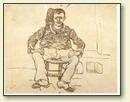| Relevant paintings: 
"Rocks and trees," Vincent van Gogh
[Enlarge]

"Olive Trees: Montmajour," Vincent van Gogh
[Enlarge]

"Landscape with train," Vincent van Gogh
[Enlarge]

"View of Arles," Vincent van Gogh
[Enlarge]

"Hill with ruins of Montmajour," Vincent van Gogh
[Enlarge]

"Ruins of Montmajour," Vincent van Gogh
[Enlarge]

"La Crau," Vincent van Gogh
[Enlarge]

"Harvest in Provence," Vincent van Gogh
[Enlarge]

"Zouave sitting, whole figure," Vincent van Gogh
[Enlarge]
|
My dear Theo,
I have just send off to you by post a roll
containing five big pen drawings. You have a sixth of that series from Mont
Majour - a group of very dark pines and the town of Arles in
the background. Afterward I want to add a
view of the whole of the ruins (you have a hurried scratch of
it among the small drawings).
Since I cannot help at all with money just at this moment
when we are entering this combination with Gauguin, I have done
all I could to show through my work that I have had the plan at
heart. In my opinion the two views of the Crau and of the
country on the banks of the Rhône are the best things I
have done in pen and ink. Not everyone would have the patience to get themselves
devoured by mosquitoes and to struggle against the nagging
malice of this constant mistral, not to mention that
I have already said more than once how much the Camargue and
the Crau, except for the difference in colour and in the
clearness of the atmosphere, remind me of the old Holland of
Ruysdael's time. I think that these two I've spoken of, the
flat countryside covered with vines and stubble fields, seen
from a height, will give you an idea of it.
Believe me I am tired out by these drawings. I have begun a
painting as well, but there is no way of doing it with the
mistral blowing - there's absolutely nothing doing.
Please let me have a line at once to say if the drawings
have arrived in good condition. They swore at me again at the
post office because they were too big, and I am afraid perhaps
they may make trouble in Paris. They took them, however, I was
glad of that, because after the celebrations of July 14 you may
be pleased to refresh your eyes with the wide-open spaces of
the Crau.
The fascination that these huge plains have for me is very
strong, so that I felt no weariness, in spite of the
really wearisome circumstances, mistral and mosquitoes. If a
view makes you forget these little annoyances, it must have
something in it. You will see, however, that there is no
attempt at effect. At first sight it is like a map, a strategic
plan as far as the execution goes. Besides, I walked
there with a painter, and he said, “There is
something that would be boring to paint.” Yet I went
fully fifty times to Mont Majour to look at this flat
landscape, and was I wrong? I went for a walk there with
someone else who was not a painter, and when I said to
him, “Look, to me that is as beautiful and as infinite as
the sea,” he said - and he knows the sea - “For my
part I like this better than the sea, because it is no
less infinite, and yet you feel that it is
inhabited.”
What a picture I would make of it if there was not this damn
wind. That is the maddening thing here, no matter where you set
up your easel. And that is largely why the painted studies are
not so finished as the drawings; the canvas is shaking all the
time.
It does not bother me when I am drawing.
Have you read Mme. Chrysanthème? It gave me the
impression that the real Japanese have nothing on their
walls, that description of the cloister or pagoda where
there was nothing (the drawings and curiosities all
being hidden in the drawers). That is how you must look at
Japanese art, in a very bright room, quite bare, and open to
the country.
Would you like to experiment with these two drawings of the
Crau and the banks of the Rhône, which do not look
Japanese, but which really are, perhaps more so than some
others? Look at them in some café where it's clear and
blue and nothing else in the way, or else outside. Perhaps they
need a reed frame, like a thin stick. Here I work in a bare
room, four white walls and a red paved floor. If I urge you to
look at these two drawings in this way, it is because I so much
want to give you a true idea of the simplicity of nature
here. Well, as to Gauguin, suppose we show the drawings, and
the harvest too, and the Zouave, to Thomas?
A handshake, and thank you for the two tubes of zinc white
that Tasset has just sent. I am curious to know if Mourier will
remember the spots.
Ever yours, Vincent
At this time, Vincent was 35 year oldSource:
Vincent van Gogh. Letter to Theo van Gogh. Written c. 13 July 1888 in Arles. Translated by Mrs. Johanna van Gogh-Bonger, edited by Robert Harrison, number 509.
URL: https://www.webexhibits.org/vangogh/letter/18/509.htm.
This letter may be freely used, in accordance with the terms of this site.
|